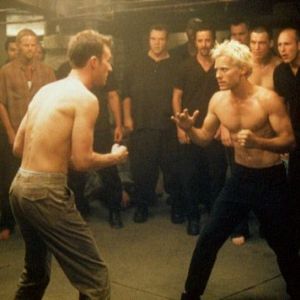Get Ready for Fight Club, 5 Principles To Increase Your Testosterone Levels
 5 Principles You Must Understand About Cranking Up Testosterone Levels
5 Principles You Must Understand About Cranking Up Testosterone Levels
To ignite your muscle gains through the room you must learn the rules to skyrocketing your testosterone levels through the roof.
This month we’ll be returning to one of my favorite anabolic targets: high-volume training combined with multijoint training.
Why is testosterone so important?
Consider it the ultimate male hormone responsible for everything about getting big and feeling like a man.
Testosterone is the primary factor behind muscle growth, fat loss, strength, sex drive, aggressiveness, and maintaining a competitive edge.
Unfortunately, our bodies are in a “death match” with our testosterone levels and we can begin to fall prey to low testosterone levels in our mid-30s and 40s.
If you don’t follow the training rules below and the nutrition and lifestyle rules, I’ll share later, then you’ll accelerate your rate of losing muscle, hair, memory, sex drive, sex appeal, and sex!
The good news is that this “leakage” of T levels as you age can be reversed and maximized naturally – with this month’s weight training guidelines, nutrition, and lifestyle strategies.
The secret is knowing which rules and lifting styles will best drive testosterone levels higher and fortunately, science has the answer.
Research shows that T levels increase quickly when you lift heavy with lots of sets, target multiple body parts per workout, rely on multi-joint exercises, and achieve short rest periods between sets.
Consider this month’s Phase your “magical supplement” that boosts hormone levels without therapy and drugs.
Principle #1: Train Heavy
Start by training with a load that you can only do around 5 reps.
This weight will be 85% of your one repetition max.
The key is to not go so heavy that you get an aneurysm but to keep the majority of the workout around your 10-rep max.
Research shows that fast and explosive style lifting has little or no change in T levels.
Principle #2: Stick With Multijoint Exercises
This ties into Principle No. 1, which demands you to lift heavy and keep yourself in check.
Using multijoint movements lets you hit the bulk of the muscle fibers so you’ll experience a greater response in T levels.

Principle #3: Pair Up The Small Groups With Big Muscle Groups Each Workout
Studies show that pairing up big muscle groups like squats, benches, and rows increases T levels more than doing tricep press downs, bicep curls, and ab crunches, even though your intensity output is the same.
One study showed when men did a bicep workout only, their T levels did not budge.
But when they trained their legs in the same workout, their T levels went up 40%.
Small muscle groups should always be paired with at least one large muscle group to give T levels a boost.
Principle #4: Crank Up The Volume
Research studies showed that workouts that achieve closer to 100 reps per workout have a great influence on T levels rather than workouts that only achieve 30-50 reps per workout.
The key is that the working load is around 75% of 1RM.
Principle #5: Rest Less
When you start extending your rest periods into “happy hour” with your buddies and trying to get the phone number of the cute front desk girl, your T levels may suffer along with your muscle gains.
Research studies show that once your rest periods extend beyond 60 seconds, T levels begin to sink.
This month you’ll keep your rest periods at 60 seconds max, which will provide plenty of time to recover, still lift heavy, and use multijoint movements without hampering your T levels.
The Sun And Testosterone!
This tip comes from the old-school bodybuilders from the 60’s and 70’s. Check it out:
The sun’s ultraviolet rays stimulate the production of luteinizing hormone, which in turn stimulates the production of testosterone.
This isn’t new news, however.
It’s more like forgotten news in the bodybuilding world.
You can find studies from the 30s and 40s that demonstrate that moderate ultraviolet radiation can have a very positive impact on testosterone production and physical conditioning.
And it wasn’t even news then, ancient athletic training regimens (Roman gladiators, Greek Olympians) often included sunbathing with the belief that the sun fed the muscles.
Turns out that they were onto something.
Ever seen Pumping Iron with Arnold?
He rested in the sun between workouts!
So why don’t you hear of it?
Two reasons: One, there is no profit in it.
And two, the reason that you’re undoubtedly thinking of, the sun has been villanized by the medical community.
We’ve been told to avoid it at all costs, wear protective clothing, or at least slop on excessive sun protection lotion.
All of this is to protect ourselves against skin cancer.
Skin cancer, however, has continued to increase right along with the sales of sunscreens.
Greater increases have been noted in urban areas where people spend more time indoors than in rural areas where people are outside much more often.
And recent studies have shown that moderate sun exposure can decrease your the risk of developing many cancers.
Vitamin D, a vitamin our bodies produce through sun exposure, and its role in maintaining health has become a very hot issue.
Many researchers and doctors are now suggesting that some sun exposure and its many noted benefits far outweigh risk factors.
No one is suggesting you get excessive sun.
You don’t want to burn.
But coming out of your cave for a bit each day may just prove a positive for your general health and provide a testosterone boost for your muscle-building goals.
In terms of testosterone, getting some sun on your back has been shown to have the greatest effect. Shoot for at least 20 minutes of outdoor activity each day.
By Vince_Del_Monte – Author, No Nonsense Muscle Building